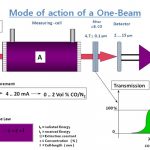Table of Contents
Humidity Measurement
“It’s not the heat, it’s the humidity!” Have you ever heard someone say that on a warm day?
To understand humidity, you first have to realize that there’s water in the air all around you. “But I’m not wet!” you might say. That’s true. Most of the air around you has water in the form of a gas called water vapor.
Let us understand about humidity through a few points: –
What is Humidity?
Easily stated humidity is simply the amount of water vapor held in the air. Water vapor is the gaseous state of water. As the temperature of the air increases more water vapor can be held since the movement of molecules at higher temperatures prevents condensation from occurring.
There are three main measurements of humidity: relative, absolute and specific. Humidity Measurement
Absolute humidity:-
Absolute humidity is a measure of the actual amount of water vapor in the air, regardless of the air’s temperature. The higher the amount of water vapor, the higher the absolute humidity. For example, a maximum of about 30 grams of water vapor can exist in a cubic meter volume of air with a temperature in the middle 80s. (units are grams of water vapor per cubic meter volume of air)
Relative humidity: –
Relative humidity expressed as a percent, is a measure of the amount of water vapor that air is holding compared the amount it can hold at a specific temperature. Warm air can possess more water vapor (moisture) than cold air, so with the same amount of absolute/specific humidity, air will have a higher relative humidity. A relative humidity of 50% means the air holds on that day (specific temperature) holds 50% of water needed for the air to be saturated. Saturated air has a relative humidity of 100%. Humidity Measurement
The relative humidity of an air-water mixture is also defined as the ratio of the partial pressure of water vapor in the mixture to the saturated vapor pressure of water at a given temperature (See what is vapor pressure). Thus the relative humidity of air is a function of both water content and temperature.
Specific humidity:
Specific humidity refers to the weight of water vapor contained in a unit weight (amount) of air (expressed as grams of water vapor per kilogram of air). Absolute and specific humidity are quite similar in concept.
What is Dew Point?
Dew Point is the temperature at which air is saturated with water and condensation begins. The higher the dew point rises, the greater the amount of moisture in the air.
How To measure Humidity?
Because so many things are influenced by humidity, it follows that there are very many effects that can be used to measure it. Some main methods are as follows:-
Hygrometer types:
Following Types of Hygrometer are used to measure Humidity.
Relative humidity sensor (electrical impedance) :-
Relative humidity sensor hygrometer based on an electronic component that absorbs water vapor according to air humidity, and changes electrical impedance (resistance or capacitance). The instrument is usually in the form of a “probe” attached directly, or by a cable, to electronics unit to display the relative humidity reading.

Condensation principle hygrometer :-
hygrometer using cooling to induce controlled condensation. The stable temperature at which this occurs is measured and reported as dew point or frost point. A usual format is a cooled mirror with optical detection of condensation used as feedback to control the mirror temperature.





Dew-point probe :-
hygrometer based on an electronic sensor changing electrical capacitance on absorbing water, capable of measuring trace levels of water vapour in very dry gases. Often scaled in units of dew point (or frost point) – hence the instrument name – but readings can be displayed in other terms.





Psychrometer (wet- and dry-bulb hygrometer)
Hygrometer using evaporative cooling as a measure of humidity. A dry thermometer is compared against one sheathed in a wet wick, in moving air. The paired temperature values can be used to find the humidity using tables or by calculation (sometimes internally calculated and displayed directly by modern psychrometers).





Mechanical hygrometer :-
hygrometer using change in length of hair (hair hygrometer) or other organic material to measure humidity. Some types record on a chart driven by clockwork or batteries. Very basic types are not powered at all. Electronic sensor-based hygrometers are usually preferred now, but many mechanical hygrometers remain in use for room monitoring.





Read Next:-
Related Search:-





Fundamentals of 4-20 mA Current Loops
Fundamentals of 4-20 mA Current Loops





I to P Converter
I to P Converter





What is source and sink in plants?
What is source and sink in plants?





Ultrasonic Level Switch
Ultrasonic Level Switch





How Infra Red(IR) Gas analyzer Work
How Infra Red(IR) Gas analyzer Work




